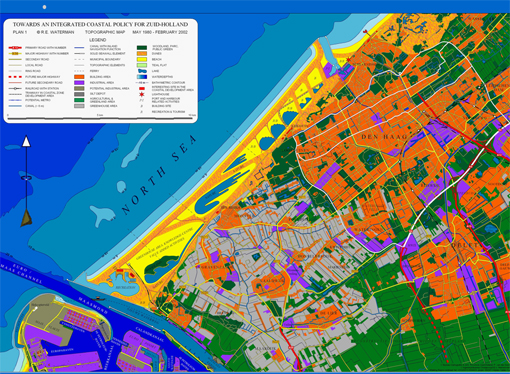'An innovative principle, based on rich Dutch traditions and resources'. That is according to Ronald Waterman the core of Building with Nature. 'For centuries the Dutch have been very effective in managing and controling the specific challenges of coastal zones, areas where water and land meet.'
To keep feet dry and heads above waterlevel, through the centuries Dutch water-land management techniques developed from artificial mounds, dykes and polders (initially using windmills, later applying steam and electric driven pumping stations) to extensive and impressive water defense and protection works such as the Zuiderzeewerken and the Delta Works.
A recent evolution of these skills shows more attention to using inorganic & organic materials and forces & interactions present in nature. The emphasis is no longer on inflexible solid bulwarks against the sea, like dams and dykes, but instead on flexible soft structures in harmony with the sea, like dunes and beaches.

Like in The Netherlands as in all the densely populated coastal areas around the world only little space is available for living, working, transport and recreation, while at the same time there is the need to preserve or even enlarge natural coastal and deltaic habitats. This is where the principle of Building with Nature fits in very well.
For the scarcity of space there are in principle three spatial solutions, apart from the necessity of in due time population stabilisation:
- Making better use of the 3rd dimension (sky scraping & underground development) and of the 4th dimension (recycling of functions) and multifunctional use within the present available space;
- Using space in the existing hinterland;
- Seaward option with flexible integration of land in water (sea, estuary, lake and/or river) and of water into the new and old land (tidal lagoons, lakes, harbour basins, canals, waterways and/or fresh water lenses under dunes), making use of materials and forces/interactions present in nature, with special attention to the intensive relation water-land.
Worldwide, all these options are applied solely, or in combination. The seaward option gives unique possibilities for the application of multi-functional use. Sustainable coastal zone development is therefore an important multi-faceted instrument to give an adequate answer to the scarcity of space, while it offers at the same time unique opportunities for an improved coastal safety as well as for an improved water resources system.

Implementing Integrated Coastal Policy by adhering to the principle of Building with Nature, using the soft solution of dunes & beaches with a minimum of “hard” elements such as rocks and jetties, or dykes & dams, about 1050 hectare of land have been reclaimed along the coastline of the Netherlands. In the coastal zones stretching from Hoek van Holland to Scheveningen, the extension of the Port of Rotterdam, and near the extension to the ports of IJmuiden/Amsterdam, integrated coastal projects have been successfully completed. And more are planned.
In addition, the principle has also been applied, albeit to a lesser degree, on most other continents including Asia, Africa and the Americas. Even in the thinly populated Australia the principle has gained popularity because it not only addresses the issue of local shortage of space for urban, industrial, residential and recreational development, but Integrated Coastal Policy and Building with Nature also represent long-term, environmentally and economically sustainable solutions.
For more detailed information on the Building with Nature principle and examples, check the chapter Principle. Or see in this 15min documentary the total scope of Ronald Waterman’s contribution.
